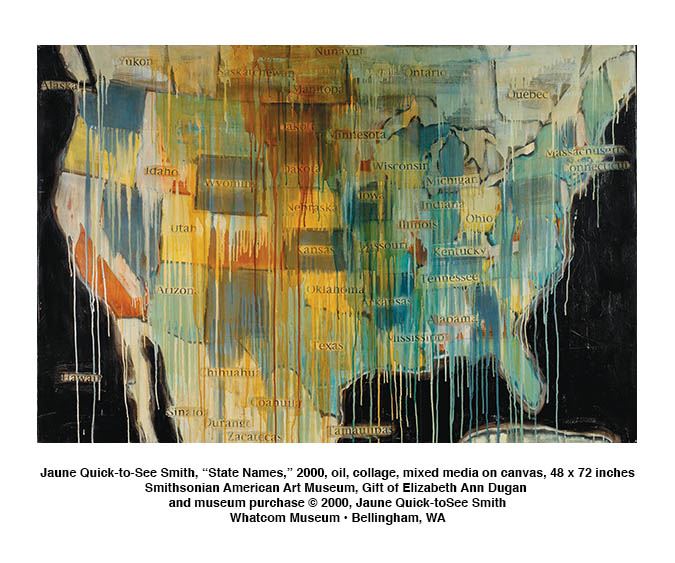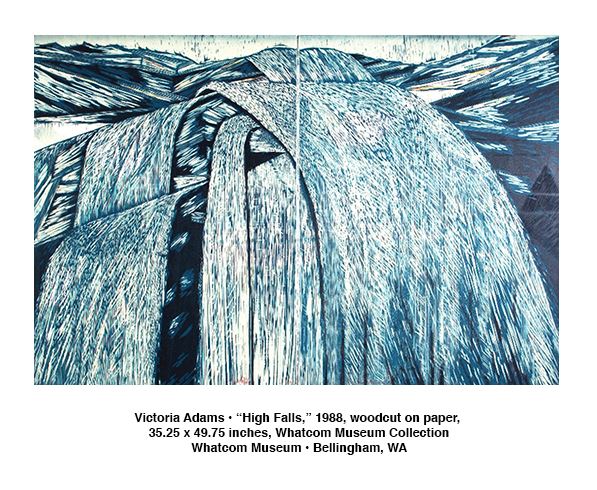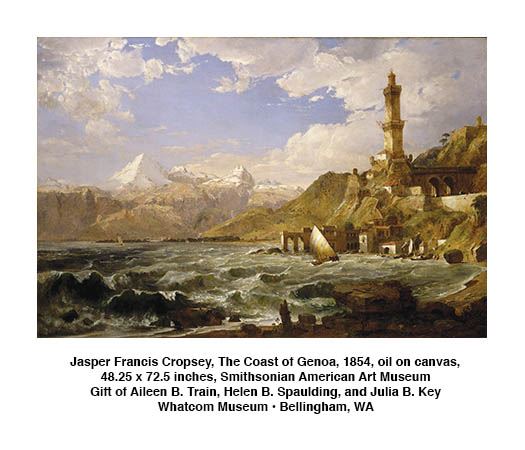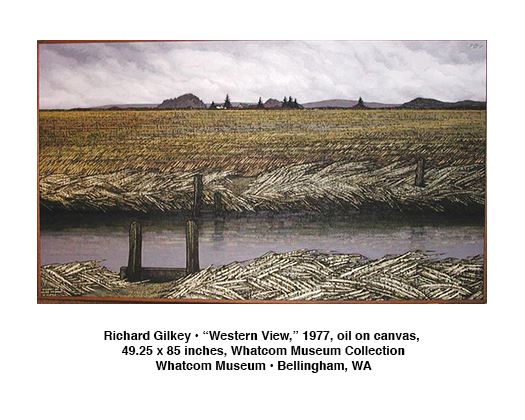
In January 2020, the Whatcom Museum announced that they are participating in an exciting new partnership with the Smithsonian American Art Museum. This five-year collaboration allows the Whatcom Museum, one of five museums in the West selected for the partnership, to borrow artworks from one of the largest collections of American art in the world. Not only does this relationship bring artworks to communities that were previously not available to them, but it also gives educators and curators the opportunity to facilitate dialogues between artworks from different regions, time periods, and styles in exhibitions. The first exhibition is titled “Conversations Between Collections: The Smithsonian American Art Museum and the Whatcom Museum” and it includes three artworks from the Smithsonian: Fritz Scholder’s “Indian and Contemporary Chair” from 1970, Jaune Quick-to-See Smith’s “State Names” from 2000, and Jasper Francis Cropsey’s painting from 1854, “The Coast of Genoa.” These loans are on display with artworks and objects from the Museum’s permanent collection in two galleries through January 3, 2021.
 The exhibition poses the question, “What is American art, and what does it look like?” When discussing the importance of the loans, Curator of Art Amy Chaloupka states, “Presenting these special masterworks in dialogue with work by American artists form our collection allows the Whatcom Museum to tell a truly expansive and complex story about what American art can look like.” The portion of the exhibition in the larger Lightcatcher gallery features landscapes from the museum’s collection alongside Cropsey’s “The Coast of Genoa.” Cropsey was a member of the Hudson River School, a group of artists who worked in the Hudson River Valley and are known for their majestic depictions of the American landscape in the midst of the industrial revolution. Cropsey’s Italian scene stands in contrast to another painting in the gallery, “Western View” by Richard Gilkey. Gilkey was a member of the Northwest School, a group of artists working in Western Washington that were brought to national attention thanks to a 1953 article in Life magazine. The painting is an excellent example of Gilkey’s style: a grey sky allows filtered, Skagit Valley light to shine down onto a windswept field. I would encourage everyone to watch Chaloupka’s virtual tour of the exhibition so that you can see a close-up of the painting, which provides a close-up of thickly applied paint, which was Gilkey’s signature technique. The virtual tour also includes two additional highlights: Victoria Adams’ “High Falls” and Paul Horiuchi’s “Rocks and Shadows.”
The exhibition poses the question, “What is American art, and what does it look like?” When discussing the importance of the loans, Curator of Art Amy Chaloupka states, “Presenting these special masterworks in dialogue with work by American artists form our collection allows the Whatcom Museum to tell a truly expansive and complex story about what American art can look like.” The portion of the exhibition in the larger Lightcatcher gallery features landscapes from the museum’s collection alongside Cropsey’s “The Coast of Genoa.” Cropsey was a member of the Hudson River School, a group of artists who worked in the Hudson River Valley and are known for their majestic depictions of the American landscape in the midst of the industrial revolution. Cropsey’s Italian scene stands in contrast to another painting in the gallery, “Western View” by Richard Gilkey. Gilkey was a member of the Northwest School, a group of artists working in Western Washington that were brought to national attention thanks to a 1953 article in Life magazine. The painting is an excellent example of Gilkey’s style: a grey sky allows filtered, Skagit Valley light to shine down onto a windswept field. I would encourage everyone to watch Chaloupka’s virtual tour of the exhibition so that you can see a close-up of the painting, which provides a close-up of thickly applied paint, which was Gilkey’s signature technique. The virtual tour also includes two additional highlights: Victoria Adams’ “High Falls” and Paul Horiuchi’s “Rocks and Shadows.” 
On the second floor of the Lightcatcher building guests can view the exhibition “People of the Sea and Cedar” which includes the other two artworks on loan from the Smithsonian, both by Indigenous artists. This exhibition is ongoing and features art and artifacts from the museum’s collection that illustrate the historic and contemporary perspectives of Northwest Coast people. Fritz Scholder and Jaune Quick-to-See Smith’s paintings are on display alongside bentwood boxes, carvings, woven blankets, and Lummi language interactives.
Both artists use expressive brushstrokes and bold colors to convey their central messages about identity, history, and leading narratives. For example, in Quick-to-See Smith’s painting the viewer immediately recognizes that it is a map of the United States. But at closer look they may observe that not every state name is present and that the state borders are blurred under long drips of paint. According to Chaloupka, the artist only included state names that are from Indigenous sources. But while the painting certainly comments on colonization, it also reminds the viewer of the resiliency and survival of Indigenous people.

The “Conversations Between Collections: The Smithsonian American Art Museum and the Whatcom Museum” exhibition is a unique opportunity to compare and reflect on the relationship between regional and national artworks while seeing them in person. Since visitors can not do that at this time, the Whatcom Museum offers two virtual tours by the art curator so that they can see the photographs of the exhibition and close-up images of some of the artworks that are included. In addition, the museum has a digital version of their Story Dome. Since the exhibition is about a sense of place, guests are invited to share a story, poem, or song about their sense of place based on prompts provided by the museum. Since everyone’s routines have been disrupted, it may be consoling to reflect on our favorite places or how we connect to our current landscape. In the end, I encourage you to check out the museum’s website for additional information and resources connected to the exhibition while we all wait to see these masterpieces in person once again.
Chloé Dye Sherpe
Chloé Dye Sherpe is a curator and art professional based in Washington State.
“Conversations Between Collections: The Smithsonian American Art Museum and the Whatcom Museum” is on view through January 3 at the Lightcatcher Building of the Whatcom Museum, located at 250 Flora Street in Bellingham, Washington. The museum is due to open during the Phase 3 of the Governor’s Safe Start Plan. For more information, visit www.whatcommuseum.org.